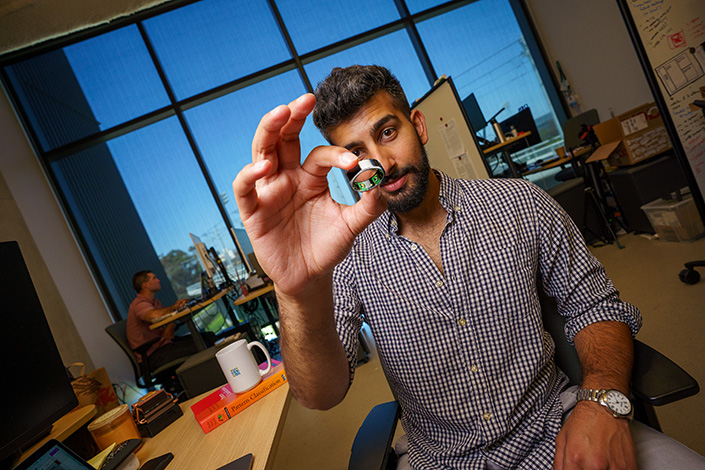Oura Ring can help combat diabetes, sleep apnea, and COVID-19
Sleep trackers could also provide critical insights into chronic conditions like diabetes, sleep apnea, and even illnesses like COVID-19

Your sleep tracker might be doing more than just telling you how well you slept. It could also be providing critical insights into chronic conditions like diabetes, sleep apnea, and even illnesses such as COVID-19. This intriguing finding comes from a recent study analyzing a massive dataset of 5 million nights of sleep data from approximately 33,000 individuals.
The researchers from the University of California San Diego (UCSD) and the University of California San Francisco (UCSF) have identified five main types of sleep, which they term "sleep phenotypes," and further subdivided these into 13 subtypes. These phenotypes offer a detailed look into the patterns and changes in sleep over time, which could be significantly more informative about health conditions than previously thought.
The research, published in the journal npj Digital Medicine, underscores how sleep patterns can reveal much more about our health than just how much rest we're getting. Using data from the Oura Ring, a smart device that monitors sleep, skin temperature, and other metrics, the researchers tracked individuals over several months. They specifically looked at whether these people had chronic conditions like diabetes or sleep apnea, or illnesses like COVID-19 and the flu.
“We found that little changes in sleep quality helped us identify health risks. Those little changes wouldn't show up on an average night, or on a questionnaire, so it really shows how wearables help us detect risks that would otherwise be missed,” said Benjamin Smarr, a senior author of the study and a faculty member in the Jacobs School of Engineering and Halicioglu Data Science Institute at UCSD.
The study revealed that the way people move between different sleep phenotypes could be two to ten times more indicative of potential health issues than just considering a person’s average sleep type.
Understanding Sleep Phenotypes
The five sleep phenotypes identified by the researchers represent distinct patterns in sleep behavior. Here's a breakdown of these types:
Phenotype 1: “Normal” Sleep: Individuals get about eight hours of uninterrupted sleep for at least six consecutive nights. This is the type of sleep most people aspire to, and it aligns with recommendations from the National Institutes of Health. It was also the most common sleep type observed in the study.
Related Stories
Phenotype 2: Alternating Patterns: These individuals sleep continuously about half the nights. On the other half, they only get short bursts of sleep lasting less than three hours.
Phenotype 3: Weekly Interruptions: Sleep is mostly continuous, but about once a week, these individuals experience a night with fragmented sleep. This disrupted night includes one long sleep period of around five hours and a shorter one of less than three hours.
Phenotype 4: Rare Mid-Sleep Waking: People usually sleep continuously, but occasionally they have nights where long sleep sessions are interrupted by waking up in the middle.
Phenotype 5: Chronic Fragmented Sleep: The rarest type found, these individuals experience very short periods of sleep every night, indicating extremely disrupted sleep.
Tracking Changes in Sleep Patterns
To measure how these sleep phenotypes change over time, the researchers created a spatial model of the 5 million nights of data. They visualized each sleep phenotype as an island within a larger "sleep landscape," allowing them to track individual routes across these islands over time.
The study found that the frequency of transitions between different sleep phenotypes was a stronger indicator of chronic conditions than the specific type of sleep a person typically had. This means that even infrequent changes in sleep patterns can provide valuable clues about a person's health.
Edward Wang, a coauthor and electrical and computer engineering faculty member at UCSD, emphasized the significance of these small changes: “We found that the little differences in how sleep disruptions occur can tell us a lot. Even if these instances are rare, their frequency is also telling. So it's not just whether you sleep well or not – it’s the patterns of sleep over time where the key info hides.”
The concept of a "sleep landscape" provides a novel way to understand sleep health. Varun Viswanath, the lead author and a graduate student in the Department of Electrical and Computer Engineering at UCSD, likens it to a map where each individual's sleep journey can be tracked. “If you imagine there's a landscape of sleep types, then it's less about where you tend to live on that landscape, and more about how often you leave that area,” he explained.
The researchers' innovative approach offers a way to visualize and quantify how sleep changes over time, which could be crucial for identifying and managing health risks.
Building on Previous Research
This study builds on previous large-scale sleep research, such as a major investigation drawing from 103,000 nights of data from the UK Biobank. However, earlier studies often only considered high-level sleep characteristics like total sleep duration and did not account for changes over time or their correlation with health outcomes.
The new research by Smarr, Wang, and their colleagues is the first to systematically quantify the dynamics of sleep over extended periods and relate these changes to health conditions. The insights gained from this study could pave the way for better understanding and management of sleep-related health risks.
Wearables like the Oura Ring are proving to be valuable tools not just for tracking sleep but for providing deeper insights into our overall health. As we continue to gather and analyze sleep data on a large scale, the potential for early detection of health issues through sleep monitoring becomes increasingly promising.
For more science news stories check out our New Discoveries section at The Brighter Side of News.
Note: Materials provided above by The Brighter Side of News. Content may be edited for style and length.
Like these kind of feel good stories? Get the Brighter Side of News' newsletter.
Joshua Shavit
Science & Technology Writer | AI and Robotics Reporter
Joshua Shavit is a Los Angeles-based science and technology writer with a passion for exploring the breakthroughs shaping the future. As a contributor to The Brighter Side of News, he focuses on positive and transformative advancements in AI, technology, physics, engineering, robotics and space science. Joshua is currently working towards a Bachelor of Science in Business Administration at the University of California, Berkeley. He combines his academic background with a talent for storytelling, making complex scientific discoveries engaging and accessible. His work highlights the innovators behind the ideas, bringing readers closer to the people driving progress.



